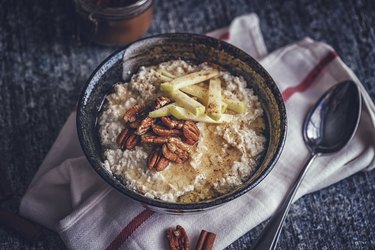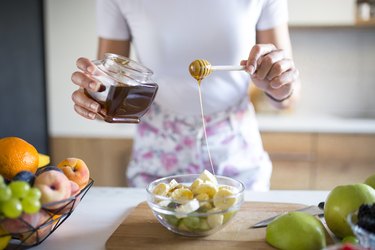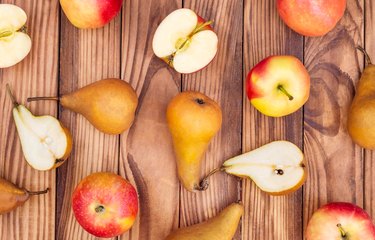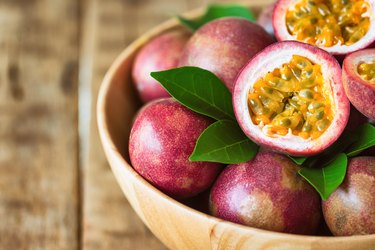
Carbohydrates can be divided into three broad categories:
- monosaccharides
- disaccharides
- polysaccharides
Video of the Day
Video of the Day
The "mono-," "di-" and "poly-" before the "-saccharides" lets us know how many saccharide chains — also known as chains of sugar molecules — are attached.
Polysaccharides have many chains and must be broken down into smaller portions before they can be fully digested. Although polysaccharides are a form of sugar, many of their food sources rarely taste sweet.
4 Examples of Polysaccharides
Because a polysaccharide is any carbohydrate made up of more than three sugar groups, there are several different categories. Here are four of the most common examples of polysaccharides:
1. Starch
The polysaccharide starch is the main carbohydrate source for plant seeds and tubers, or vegetables that grow in the ground. While most vegetables are relatively low in carbohydrates per serving, starchy vegetables typically have 15 grams of carbohydrates per 1/2 cup cooked, per Johns Hopkins University.
Starchy vegetables include corn, potatoes, green beans, winter squash, cassava and beans. Other examples of starches include bread, cereal, rice and pasta.
The body breaks starches down into glucose, or sugar, which gives you energy. Many of these foods are high in resistant starch, which isn't digested but ferments in the colon and feeds the good bacteria there, per a February 2020 article in the Journal of the Academy of Nutrition and Dietetics.
2. Cellulose
Cellulose is a polysaccharide that provides a protective covering and structure to fruits and vegetables and their seeds. Cellulose is a form of insoluble fiber and is not digestible, so it helps add bulk to your stool and maintain good digestion, per a June 2012 article in the Journal of Food Science and Technology.
Many fruits and vegetables have cellulose. It can be found in the skins of apples and pears, in the covering of whole grains like wheat bran and in plant leaves like spinach.
3. Glycogen
Glycogen is a polysaccharide made in the body after eating sources of carbs. This makes it different than the other polysaccharides as it's not one that we eat, but rather one that we make to store energy in the body.
When you eat carbs, either in the form of simple sugars or more complex carbohydrates like starch, and don't need the energy (glucose) from that food right away, your body stores it as glycogen in the liver and muscles, per the Cleveland Clinic.
When you need to use that stored energy, glycogen converts back to glucose, so that you have a steady supply in your bloodstream to fuel your cells.
4. Pectin
Pectin is a polysaccharide, also known as soluble fiber, that helps to form a gel-like substance when broken down in the body. Soluble fiber is great because it improves bowel function and can help manage cholesterol levels, per a September 2021 article in Current Allergy and Asthma Reports.
Pectin helps jams and jellies set into a gel-like consistency. This powder is often produced from fruit peels, like apples and citrus fruits, which are natural sources of pectin, according to the Michigan State University Center for Research on Ingredient Safety.
10 Foods High In Polysaccharides
1. Pasta
While pasta can be made out of anything from rice to chickpeas, zucchini and even hearts of palm these days, traditional pasta made from wheat flour is high in the polysaccharide starch.
A 1/2 cup of whole-wheat spaghetti has 18 grams of carbohydrates, including 2.3 grams of fiber. It's also a good source of niacin, copper, selenium and manganese.
2. Pears
Pears are a good source of both pectin and cellulose, and the amount of each polysaccharide changes with how ripe the fruit is, according to a January 2017 study in Carbohydrate Polymers.
One medium Bartlett pear has 26.6 grams of carbs, 5.5 grams of fiber and 17.2 grams of sugar. Adding pears to a meal or snack is a great way to enjoy the flavor and nutritional benefits while also getting a healthy dose of protein and fats. Try one of these gut-healthy dishes that use pears.
3. Oatmeal
Oats are made of cellulose and another type of polysaccharide known as beta-glucan, per a September 2018 article in the Polish Journal of Microbiology. Like cellulose, beta-glucans are a type of soluble fiber.
The U.S. Food and Drug Administration (FDA) approves the health claim that eating over 3 grams of beta-glucan soluble fiber from foods like oats or barley can reduce the risk of coronary heart disease.
One cup of cooked oatmeal has 28 grams of carbs, 4 grams of fiber and 6 grams of protein. Mix in toppings like fruit and nuts for a satisfying and filling breakfast, or try these savory oatmeal dishes to mix things up.
4. Lentils
Lentils are high in protein and rich in the polysaccharides starch and cellulose. A 1/2 cup of cooked lentils has 20 grams of carbs, 8 grams of fiber and 9 grams of protein. Lentils are also a good source of iron, folate and vitamin B1.
If you're looking to eat more plant-based foods without sacrificing protein, try these lentil recipes high in protein, fiber and flavor.
5. Green Beans
Green beans are high in cellulose and pectin, both of which slowly degrade as green beans age and soften, according to an October 2013 study in the International Journal of Food Properties.
Green beans are considered a non-starchy vegetable, as they're low in carbohydrates and do not have a significant effect on blood sugar. One cup of green beans has 8 grams of carbs, 4 grams of fiber and is an excellent source of vitamin C.
6. Corn
Corn is high in starch and has a significant amount of carbohydrates per serving. A 1/2 cup of yellow sweet corn has 16 grams of carbs, 2 grams of fiber and 3.5 grams of sugar.
Not sure the best way to make your corn? Steaming corn is the preferred method over boiling to preserve important nutrients like B vitamins and vitamin C. Grilling corn while it's still on the cob is also a fun way to eat this summertime favorite.
7. Oranges
Pectin and cellulose can be found in orange peels and the fruit itself. Cellulose and pectin are often extracted from orange peels to be used for industrial purposes because the amount is so high and orange peels are a major product of food waste, according to a March 2022 article in the Journal of Materials Research and Technology.
One small orange has 11 grams of carbs, 2.3 grams of fiber and 9 grams of sugars. While you can enjoy the citrus on its own, you can also try one of these orange recipes.
8. Black Beans
Black beans, along with other legumes, are high in starch. A 1/2 cup of black beans has 20 grams of carbohydrates, 7.5 grams of fiber and 7.5 grams of protein. They're also a good source of iron, magnesium and folate.
Some of the carbohydrates in black beans digest slowly while others are undigestable, like the soluble and insoluble fiber, and help to feed good bacteria in the colon, per an August 2017 article in Molecules.
Black beans are an obvious choice for dishes like tacos or burrito bowls, but they're also an amazing way to add fiber and protein to sweets too: Try one of these desserts made with black beans!
9. Bananas
Bananas are high in pectin and cellulose and sometimes starch.
Unripe bananas can have as much as 21 grams of starch per 3.5 ounces of banana while ripe bananas only have 1 gram of starch per 3.5 ounces of fruit, per a July 2021 article in PLOS One. That's why less ripe, yellow-green bananas are great for gut health.
Fun fact: As the banana ripens, the starch breaks down into simpler sugars, resulting in a sweeter taste. One medium banana has 27 grams of carbs, 3 grams of fiber and 14 grams of sugar.
10. Asparagus
Like all fruits and vegetables, asparagus does have some pectin, but it's especially high in the polysaccharide cellulose.
Because of the high cellulose content of asparagus and the large amount of waste that this vegetable produces from discarding the ends, researchers have found ways to use asparagus cellulose to make film for food packaging, per a March 2021 study in Food Science and Human Wellness.
One cup of cooked asparagus has 7 grams of carbs, 3.5 grams of fiber and 2.3 grams of sugar. Try this simple but delicious Blood Orange Asparagus Saute.
- The John Hopkins Guide to Diabetes: "The truth about starchy vegetables"
- Journal of the Academy of Nutrition and Dietetics: "Resistant Starch Content in Foods Commonly Consumed in the United States: A Narrative Review"
- Journal of Food Science and Technology: "Dietary fibre in foods: a review"
- Cleveland Clinic: "Glycogen"
- Current Allergy and Asthma Reports: "The Dietary Fiber Pectin: Health Benefits and Potential for the Treatment of Allergies by Modulation of Gut Microbiota"
- Michigan State University Center for Research on Ingredient Safety: "Summer Staple- Pectin"
- USDA: "Spaghetti noodles"
- Carbohydrate Polymers: "Characterization of tissue specific differences in cell wall polysaccharides of ripe and overripe pear fruit"
- USDA: "Bartlett Pear"
- FDA: "CFR - Code of Federal Regulations Title 21"
- USDA: "Cooked Oatmeal"
- USDA: "Cooked Lentils"
- International Journal of Food Properties: "Characteristics of Cell Wall Structure of Green Beans During Controlled Freezing Point Storage"
- USDA: "Green Beans"
- USDA: "Yellow Sweet Corn"
- Journal of Materials Research and Technology: "Bio-based material from fruit waste of orange peel for industrial applications"
- USDA: "Oranges"
- USDA: "Black Beans"
- Molecule: "Bioactive Compounds from Mexican Varieties of the Common Bean (Phaseolus vulgaris): Implications for Health"
- PLoS One: "Dietary fiber, starch, and sugars in bananas at different stages of ripeness in the retail market"
- Food Science and Human Wellness: "Preparation and physicochemical/antimicrobial characteristics of asparagus cellulose films containing quercetin"
- USDA: "Cooked Asparagus"


